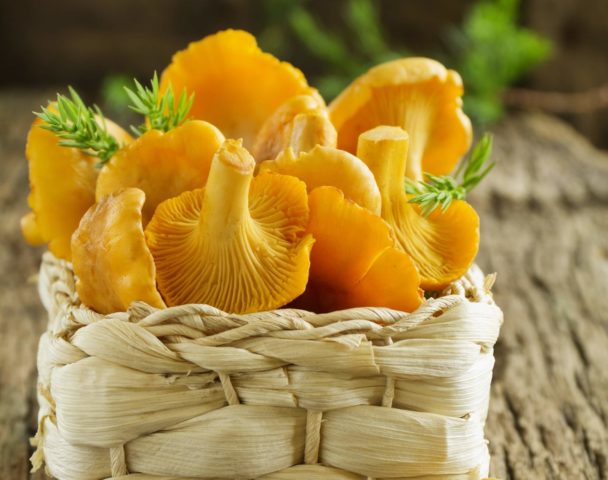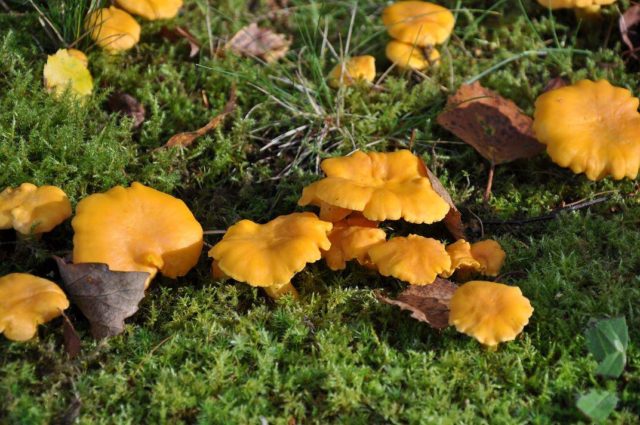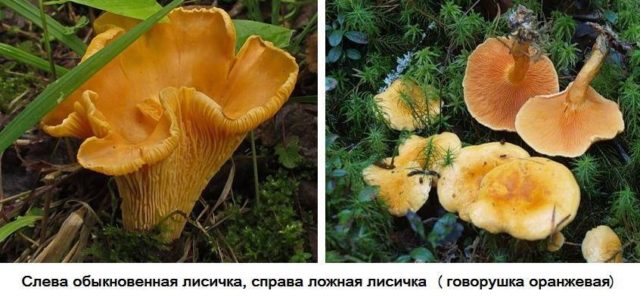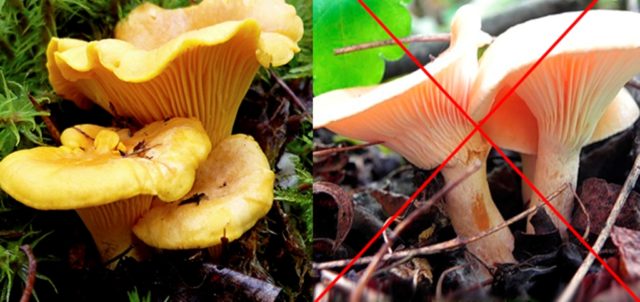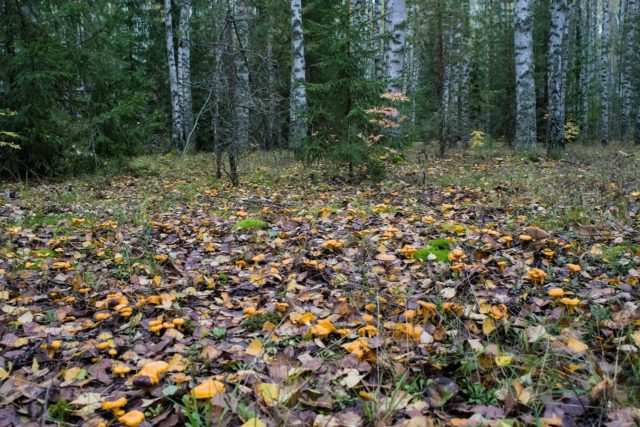Content
The chanterelle is one of the most popular forest mushrooms, which will decorate even a festive table. It is distinguished by a unique taste and aroma, with which only white representatives can be compared. This mushroom is distinguished by its bright, memorable appearance.
What real chanterelles look like
It is advisable to have this information before going on a "mushroom hunt" in order to know exactly what to fill the basket with. By the way, the name comes from the word "fox", that is, yellow. For convenience, a number of features are distinguished:
- Unlike most brethren, the color of the common chanterelle can vary, changing, depending on conditions, from orange to brown;
- If mushrooms are characterized by the shape of an umbrella, then in the common chanterelle this umbrella is as if bent by the wind in the opposite direction;
- The fruiting bodies are one whole, since there is no visible transition from stem to cap.
It is quite simple to recognize the common chanterelle by these signs. And after finding one, you should look around. This species usually grows in large families. The place must be remembered and returned to it next time.
Where do chanterelle mushrooms grow
Those who regularly go to the forest often compare common chanterelles with fox tails that stick out of holes. Mushrooms hide in last year's needles or foliage, so you should arm yourself with a stick, with which it is easy to lift it. The common chanterelle prefers birch or mixed forests. Less often you can find it in the coniferous forest.
What places to check first:
- After the past rains, you should inspect areas with light, sandy soil, and also pay attention to forest edges or sunny glades;
- The rest of the time, you should look for common chanterelles in wet areas near birches and oaks.
The first fruiting bodies appear in May and are found in the forest until September. But the massive collection falls on July - August.
Description of the common chanterelle
The large leg of the chanterelle smoothly turns into an umbrella, the diameter of which is different: there are specimens with a cap from 2 to 12 cm.If you carefully examine it, you can see the features:
- Inhomogeneous color: pale at the edges and almost brown in the center;
- The dome is elongated or convex: this depends on the season and age of the fruiting body;
- The skin is smooth, the edges of the funnel are rounded, wavy;
- The pulp is dense, of the same color as the dome. Thanks to this, the mushroom perfectly tolerates long-term transportation and storage;
- The peel from the pulp is separated with great difficulty.
It is not for nothing that experts value the common chanterelle so much. Collecting it is a pleasure, it is not a hassle to transport, it goes well with various dishes.
Mushroom taste
It is not for nothing that the common chanterelle has gained such popularity. This is one of the most delicious mushrooms growing in our forests. If you need the dish to turn out fragrant, then it's better not to come up with anything. It is not for nothing that the recognition of the culinary experts was received by the chanterelles. Real mushrooms can be added to salads and canned. Even gourmets will love soups with dried chanterelles. But they are most delicious when fried.
Mushroom pickers love them for their dense meatiness and a special sour taste with the smell of roots and fruits. But unlike milk mushrooms or valuy, ordinary chanterelles do not have bitterness and therefore do not require soaking. After roasting, they acquire the necessary softness without losing their shape. Small mushrooms are especially good for decorating the finished dish.
It is best to use as a side dish with the product: buckwheat; pasta; Brown rice.
Common chanterelles can be used as an independent dish, added to pizza and casseroles, and used as a pie filling. They go well with spices such as allspice, dill, cloves, marjoram, dried carrots and bay leaves.
Beginners sometimes pass by ordinary chanterelles, not honoring yellow mushrooms with attention: honey mushrooms and porcini will really give this species a head start in digestibility, but the chanterelle also has a number of undeniable advantages:
- If you cook them correctly, grinding them before heat treatment, then all the useful properties will be fully preserved.
- The calorie content of the mushroom is very small - 19 kcal per 100 g of product. At the same time, common chanterelles contain dietary fiber (23%), beta-carotene (17%), vitamins: A (16%), B2 (19%), C (38%), PP (25%), as well as potassium ( 18%), copper (29%), manganese (21%), cobalt (40%);
- Nutritionists note that a high protein content with a low calorie content is an excellent aid for weight loss. Of course, with a diet.
False doubles
Most mushrooms have twins, and the real (ordinary) chanterelle is no exception: the photo clearly shows that you can distinguish them. but for this you need to have certain knowledge or skill. For those who visit the forest regularly, the difference is obvious. With a little practice, you can easily tell them apart.
Despite the fact that some believe that the false chanterelle is an unwanted guest in a basket with forest gifts, however, it refers to conditionally edible, not poisonous mushrooms. Having eaten it, you can face digestive upset, and most people will not feel any damage to their health at all. After soaking, the doubles can be dried, salted and even fried. Another thing is that their taste leaves much to be desired.
Features:
- The first thing that is important to pay attention to the mushroom picker is the place of growth. A false analogue - an orange talker - is found on dead wood, on old trees, and also on forest litter.
- A false representative grows in single specimens, which never happens with ordinary chanterelles, which always come across families.
- The cap of the orange talker has regular and even edges, the skin can be easily removed from it: while the edges of the common chanterelle are wavy, and the skin is separated with great difficulty.
- Bad smell is another indicator. If the common chanterelle smells like apricots, then the false one has a musty aroma.
- When pressed, the common chanterelle changes color to red: a false mushroom does not have this property.
- The main difference is the leg. In the chanterelle talker, it is thin and hollow inside, in the ordinary one - thick, without voids.
Collection rules
Going into the forest, you need to once again remember where and how chanterelles grow, pay attention to the weather and the amount of precipitation. If the summer is moderately warm and rainy, then you can go hunting in early July. In extreme heat, the mass harvest is postponed to August-September. The most important thing is to find the first hat. After that, it remains only to explore the entire clearing in order to collect several buckets of orange fruit bodies.
Experienced mushroom pickers usually give advice to beginners:
- You need to cut the common chanterelle with a sharp knife, 1 - 2 cm above the ground surface. If you pull it out by the roots, then a lot of earth and sand will get into the plates.
- An overgrown specimen will not replenish the prey, but it should not be left in the ground either. Better to cut and hang on a tree, head down. The spores will spill out and a new crop will appear in a couple of years.
How the mushroom grows can be seen in the photo. The common chanterelle will appear in the same meadow year after year, if you handle the mycelium with care.
The use of common chanterelles
For their unique composition and suitability for food in any form, common chanterelles are valued not only in cooking, but also when used to heal the body:
- In cooking, this representative of the Chanterelle family allows you to diversify the table and prepare many delicious dishes.
- For weight loss, this is a real find, since a valuable source of protein has a low calorie content, which allows it to be included in the diet menu. Moreover, a powder is prepared from dried fruit bodies, which is taken twice a day, in a teaspoon, which also stimulates weight loss.
- In folk medicine, they have a stimulating and antitumor effect, helping with inflammatory diseases.
- In cosmetology, the adaptogenic or fortifying function of the product is appreciated, which is used in the main or additional components of cosmetic or medical-cosmetic formulations.
How to cook common chanterelle
An ordinary chanterelle is almost impossible to spoil, so it is suitable for experiments with novice housewives:
- Zakuska for every day. This is a light salad of fried chanterelles, boiled potatoes, green onions, cherry tomatoes and lettuce leaves. The proportions are arbitrary, it is better to season with sour cream or olive oil with lemon juice.
- Fragrant soup. To prepare it, you need to fry the potatoes, add onions and chanterelles to it. Stir, keep on fire for another five minutes, transfer to a saucepan and cover with water. Cook everything for 20 minutes, then grind with a blender, add cream, salt and pepper. Truffle oil will add a special aroma to the dish.
- Chanterelle mousse. Perfectly complements any side dish. For cooking, you will need to fry the mushrooms in vegetable oil, add cream and simmer until tender. Cool slightly and grind with a blender.
- Pickled chanterelles. Sort out the mushroom raw materials, add water and boil for 10 minutes. Add spices and vinegar (for 1 kg of mushrooms - 100 ml of water, 1 tablespoon of sugar and ½ tablespoons of salt, 125 ml of 9% vinegar).
Fried chanterelles can be used to decorate a salad, meat or vegetable dish: they will only benefit from this.
Medicinal uses of the mushroom
Common chanterelles are used in folk medicine in the form of powder, alcoholic tinctures or oil extract. Moreover, they can be bought ready-made or prepared independently. The most popular was alcohol tincture. With its help they treat:
- Liver disease;
- Pharyngitis, sore throat, SARS and tuberculosis;
- Oncological diseases;
- Skin lesions of various etiologies.
Alcohol tincture is easy to prepare at home. You will need to take 2.5 tbsp. l. powder from ordinary chanterelles and pour them with 500 g of vodka. It is necessary to infuse the mixture in the dark for 2 weeks. This tincture is taken:
- When treating the pancreas, drinking 1 tsp. twice a day;
- To cleanse the liver - 2 tsp. before going to bed, within two weeks;
- To remove worms - 2 tsp. before bed, for 3 weeks.
Conclusion
In Russia, the common chanterelle is found almost everywhere. It grows in forest belts, small groves and protected forests. For a beginner, this is a great chance to bring home a really tasty and healthy mushroom, without the risk of poisoning. Representatives of the Lisichkovs are easily recognizable and do not look like any other species. And if a false chanterelle falls into the basket, then, if precautions are taken in cooking, it will not become a threat to health.
Ginger beauties are easy to cook. You don't need to be a master cook to fry them and make them a great alternative to goulash or soup base. The low calorie content allows them to be safely eaten even during a diet, which increases the demand for chanterelles among women and athletes.
